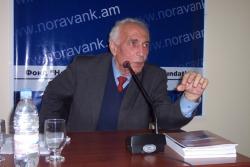NORAVANK LECTURING LEMVEL VALESYAN: ARMENIANS IN UP-TO-DATE WORD: GENERAL DEMOGRAPHIC PICTURE
 On November 23 in “Noravank” Foundation was delivered a lecture on the subject “Armenia and Armenians in global developments: up-to date condition and challenges” (lectured by Lemvel Valesyan: specialist of social and political geography, doctor, professor of geographical science, academician of Teacher’s Training International Academy) in accordance with the “Noravank” educational program on “Armenia and the Armenians in global developments: the present situation and challenges.” Professor Valesyan’s lecture opened the second phase of “Noravank” readings on “Contemporary Armenians’ demographic and Armenian inhabited Armenians’ social problems.”
On November 23 in “Noravank” Foundation was delivered a lecture on the subject “Armenia and Armenians in global developments: up-to date condition and challenges” (lectured by Lemvel Valesyan: specialist of social and political geography, doctor, professor of geographical science, academician of Teacher’s Training International Academy) in accordance with the “Noravank” educational program on “Armenia and the Armenians in global developments: the present situation and challenges.” Professor Valesyan’s lecture opened the second phase of “Noravank” readings on “Contemporary Armenians’ demographic and Armenian inhabited Armenians’ social problems.”
According to the lecturer, the Armenians became known to the humanity by their universal image and as an ethnographic entity for about 5000 years ago. The Armenians belong to the anthropological type of Armenoid or Advanced-Asian Europoid big race. Within centuries the anthropological type has underwent some changes; however, the main characteristic traits has been preserved. Different researchers mention the following characteristic traits peculiar to the image of Armenians: diligence, assiduity, amicability, stability, hospitability, love for education, business undertakings, trade and military science.
As the approximate calculations have shown for about 60-70 million people lived in the world for 5000 years ago, 40-45 million of which lived in the south of Europe; according to different calculations, in the beginning of our epoch the population of the planet, made 100-400 million people.
Approximate calculations have shown that in the first century BC on the territory of Great Armenia lived 2.5-3 million Armenians. Accordingly, 2000 years ago the population of Armenia made 1-3% of the world population. Today, the number of the world population makes 6.5 billion, the number if Armenians makes from 6.5 to 9 million (acceding to different data), however, Armenians make 0.01% of the world population. During the past thousands of years many tribes and even nations, a number of states and empires were wiped away from the world map, and a part of them was from the region of Advanced Asia. Geopolitical changes couldn’t but influences on Armenia situated on the crossroad of civilizations, however, the Armenians were able to be preserved as a nation. Their specific gravity among the world humanity was preserved but was considerably reduced. Even in 11-12 centuries, according to approximate calculations, for about 7 million Armenians were counted in the world. If the historical situation hadn’t undergone considerable changes influencing on the normal demographic rise of Armenians, the Armenians would have been one of the biggest nations.
In the beginning of the XX century only 1/3 of the Armenian ethnos lived in the historical Motherland. Let’s mention that very few nations in the world have such a ratio of native land inhabitants and Diaspora inhabitants. However, we have got some more examples. For more than half a century ago one could witness such a situation in Judea. When the sate of Israel was being created, only a few hundred thousand people were inhabited on its territory, but today it has a population of 5.5 million people. The number of Armenians inhabited in Diaspora has begun exceeding the number of ones inhabited in Armenia since 1920s. Within the coming 70 years, in comparison with the last few centuries of the Armenian history, the tendency of repatriation was prevailing. However, the situation again changed in 1990s because of social economic crisis. According to the specialists, but for this crisis which resulted emigration, at present Armenia would have had a population of 4.5 million.
Armenian Diaspora, which was formed after the Genocide of 1915, has formed communities in 75 UN countries out of 194. At the same time the professor mentioned that “dispersion is not the sign of power: what is more advantageous: existence of Armenians in a country spread in many villages or Armenian inhabited cities and districts in big cities, communities which can influence on the state policy to accept pro-Armenian decisions?”
Today one can witness the process of formation and empowering Pan-Armenian organizations, there is an Armenian statehood, and all this is a powerful factor to unify Armenians. According to L. Valesyan, besides gathering money, the annual TV marathons of the Pen-Armenian foundation “Hayastan” pursuit the aim of reviving feeling of belonging to all-Armenian, unification of Armenians around national ideas.
Today, the process of the Armenian nation’s existence is displayed in two contradicting tendencies. From the one hand, there is a rise of national self-consciousness, from the other hand, there is a strong tendency of individuals, good specialists to live, work and create outside Armenia, because they are sure that there are little chances of self-realization in the native land.
During the discussion following the lecture in answer to the question what is the estimation of the Armenian specialists to the natural resources of Armenia and the Nagorno-Karabakh Republic, L. Valesyan answered that according to some approximate, incomplete estimations the mentioned territory had enough natural resources for 4,5 million people. Basing on theoretical calculations, the scientist have come to the conclusion that in the epoch of collective economic structure 3 hectares could feed only one person, in the agricultural epoch the same 3 hectares could feed 10 people and under present conditions the same territory is enough to feed 100 people. Let’s again mention that these calculations are conditional and L. Valesyan brought examples of the same 3 hectares, which could feed a few thousand people undergoing corresponding cultivation.


